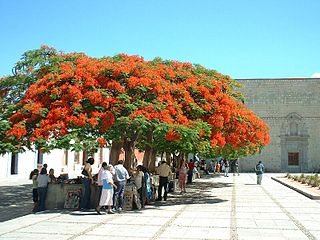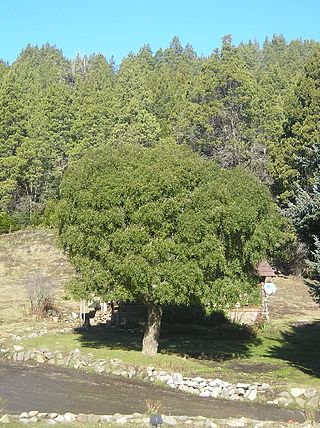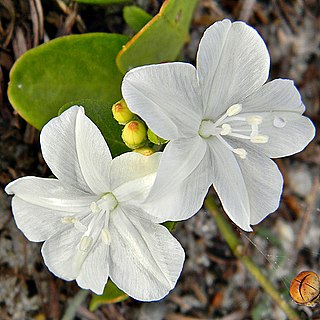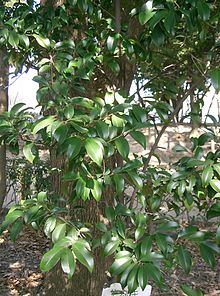
Caesalpinioideae is a botanical name at the rank of subfamily, placed in the large family Fabaceae or Leguminosae. Its name is formed from the generic name Caesalpinia. It is known also as the peacock flower subfamily. The Caesalpinioideae are mainly trees distributed in the moist tropics, but include such temperate species as the honeylocust and Kentucky coffeetree. It has the following clade-based definition:
The most inclusive crown clade containing Arcoa gonavensisUrb. and Mimosa pudicaL., but not Bobgunnia fistuloides(Harms) J. H. Kirkbr. & Wiersema, Duparquetia orchidaceaBaill., or Poeppigia proceraC.Presl

Xylosma is a genus of flowering plants in the family Salicaceae. It contains around 100 species of evergreen shrubs and trees commonly known as brushhollies, xylosmas, or, more ambiguously, "logwoods". The generic name is derived from the Greek words ξύλον (xylon), meaning "wood, tree", and ὀσμή (osmé), meaning "smell", referring to the fragrant wood of some of the species. The Takhtajan system places it in the family Flacourtiaceae, which is considered defunct by the Angiosperm Phylogeny Group.

Zanthoxylum is a genus of about 250 species of deciduous and evergreen trees, shrubs and climbers in the family Rutaceae that are native to warm temperate and subtropical areas worldwide. It is the type genus of the tribe Zanthoxyleae in the subfamily Rutoideae. Several of the species have yellow heartwood, to which their generic name alludes. Several species are cultivated for their use as spices, notably including Sichuan pepper.

Myrica is a genus of about 35–50 species of small trees and shrubs in the family Myricaceae, order Fagales. The genus has a wide distribution, including Africa, Asia, Europe, North America and South America, and missing only from Australia. Some botanists split the genus into two genera on the basis of the catkin and fruit structure, restricting Myrica to a few species, and treating the others in Morella.

Ormosia is a genus of legumes. 131 living species, mostly trees or large shrubs, are native to the tropical Americas, from southwestern Mexico to Bolivia and southern Brazil, to southern, southeastern, and eastern Asia, and to New Guinea and Queensland. Most are tropical, while some extend into temperate temperate regions of China. A few species are threatened by habitat destruction, while the Hainan ormosia is probably extinct already.

Adinandra is a genus of plant in the family Pentaphylacaceae. It contains the following species:

Banara is a genus of flowering plants in the family Salicaceae.

Gymnosporia is an Old World genus of plants, that comprise suffrutices, shrubs and trees. It was formerly considered congeneric with Maytenus, but more recent investigations separated it based on the presence of achyblasts and spines, alternate leaves or fascicles of leaves, an inflorescence that forms a dichasium, mostly unisexual flowers, and fruit forming a dehiscent capsule, with an aril on the seed. It is dioecious, with male and female flowers on separate plants.

Maytenus is a genus of flowering plants in the family Celastraceae. Members of the genus are distributed throughout Central and South America, Southeast Asia, Micronesia, and Australasia, the Indian Ocean and Africa. They grow in a very wide variety of climates, from tropical to subpolar. The traditional circumscription of Maytenus was paraphyletic, so many species have been transferred to Denhamia and Gymnosporia.

Sloanea is a genus of flowering plants in the family Elaeocarpaceae, comprising about 150 species.

Ternstroemia is a genus of flowering plants in the family Pentaphylacaceae. It is distributed in tropical and subtropical regions in Africa, Asia, and the Americas.

Rondeletia is a genus of flowering plants in the family Rubiaceae. It is endemic to the Neotropics. There are around 160 species.

Ceriops is a genus of mangroves in family Rhizophoraceae.

Galactia is a genus of plants in the legume family (Fabaceae). It belongs to the subfamily Faboideae and tribe Diocleae They do not have an unambiguous common name, being commonly called milk peas, beach peas or wild peas. They are perennial herbs or subshrubs with prostrate, climbing, or erect forms.

Cassine is a genus of trees, of the plant family Celastraceae.

Callicarpa (beautyberry) is a genus of shrubs and small trees in the family Lamiaceae. They are native to east and southeast Asia, Australia, Madagascar, southeast North America and South America.

Jacquemontia is a genus of plants in the morning glory family Convolvulaceae. Species in this genus are commonly known as clustervine.

















